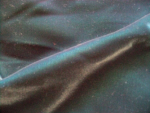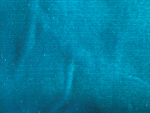|
Velvet Fabric – An Elegant Member Of The Pile Family Of Fabrics
Velvet fabric is a sister fabric to both velour and velveteen, and of the three is the one most used for creating elegant designs. In addition to being a member of the pile family of fabrics, velvet fabric is also a member of the larger cotton family of fibers. In addition, as confusing as it may seem, velvet also comprises its own family of fabrics, consisting of: bagheera; burn-out, brocaded or voided velvet; chiffon velvet; crushed; cut; devore; faconne; Lyons; mirror; nacre; panne; sculpted; and transparent velvet.
Velvet was originally made of silk, but is now made of such fabrics as cotton, rayon, acetate, polyester, and fiber blends. Velvet is also a woven fabric.



Fabric Characteristics:
• Has a pile and requires a nap layout • More difficult to sew than other pile fabrics • It usually requires extra fabric for a project • Easily marred by pins, stitching mistakes, alterations, heat, moisture, and improper pressing • Most creep badly and sometimes pucker during stitching • The pile sheds badly at the raw edges • Some fray badly • Some are bulky • Most must be dry cleaned • Cotton velvet is the most durable • Acetate velvet is easily damaged by moisture and pressure
Working With These Fabrics Requires:
• Sewing machine needles should be sizes 60/8-80/12 sharps and universals depending on the fabric weight • Hand sewing needles should be sizes 7-9 • Sewing machine settings used should be a stitch length of 2-3mm • Sewing machine feet recommended are the roller, walking, and zipper foot • Thread should be all-purpose cotton, polyester, cotton/polyester blend and for hand basting silk or unglazed cotton • Tools and equipment recommended is sharp scissors, sharp shears, pins • Layout should be nap, single layer, wrong side up • Marking tools recommended are chalk, clips (snip marks in seams), and tailor tacks • Seams recommended are plain, taped, piped and tissue stitched • Hems recommended are plain, hand blindstitch, hand catchstitched, hand blind catchstitched, hand double stitched • Seam and hem finishes recommended are single ply, unfinished, pinked, pinked-and-stitched, multi-stitch zigzag, serged, Hong Kong to name a few • Edge finishes recommended are self-fabric facings, smooth fabric facings, bands, ribbings and bindings • Closures and pockets can be all types • Interfacings used should be for cotton velvets fusible and sew-ins and for other types of velvet sew-ins • Underlings are rarely used • Pressing recommended is a steam iron on a medium setting
These Fabrics Are Suitable For:
Velvet fabric is recommended for full pants, skirts, vests, capes, dresses, gored skirts, loose and boxy or semi-fitted jackets, and children’s dressy garments. Velvet is primarily used for elegant dressy designs.
For information about the notions, tools, and equipment required to complete a sewing project, click here to view the sewing notions home page
For more information about this family of fabrics some great references are: Claire Shaeffer’s Fabric Sewing Guide
More Fabric Savvy by Sandra Betzina
All About Cotton – Julie Parker’s Fabric Reference Series
For more interesting information about velvet fabric click here on Wikipedia.org
and click here on fabrics-manufacturers.com
and
click here on the freedictionary.com for a nice definition of velvet
To continue exploring information about fabrics follow the links below.
Vinyl Fabric
|




